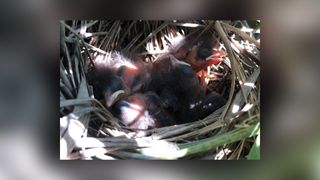Video captures unusual death of baby bird drowned by a fish
In a deadly "birds vs. fish" encounter, the fish emerged as the winner.

When a sparrow's nest flooded during high tide in coastal Georgia, a fish jumped at the chance to make a meal of a newly hatched chick, and a scientist's video camera caught a first-ever view of the entire deadly encounter.
Footage showed a small fish called a mummichog (Fundulus heteroclitus) leaping into a flooded nest and attacking a hatchling seaside sparrow (Ammospiza maritima), demonstrating that baby sparrows in this habitat face a threat previously unknown to scientists.
Corina Newsome, an ornithologist at the Hunter Lab at Georgia Southern University in Statesboro, had placed cameras on the birds' nests to learn about the risks posed by predators. In this case, the predator came from an unexpected place: the water.
"A lot of questions were spinning in my mind after seeing that," Newsome told Live Science.
Related: Beastly feasts: Amazing photos of animals and their prey
Tidal salt marshes in Georgia are home to many types of birds, and seaside sparrows that live there are known to build their nests in spots prone to flooding when the tide rises, Newsome and her co-authors reported Feb. 5 in The Wilson Journal of Ornithology. This can be hazardous for young chicks, though they often survive minor floods, according to the study.
But choosing a drier nesting site that's higher up can leave hatchlings more exposed to a number of predators, Newsome said. Bigger birds such as crows or grackles find baby sparrows delicious, as do raccoons, marsh rice rats and American minks; and sparrow chicks tend to be safer in nests that are closer to the ground, as this provides them with protective cover.
Sign up for the Live Science daily newsletter now
Get the world’s most fascinating discoveries delivered straight to your inbox.
Salt marshes are also inhabited by the hardy mummichog. These fish measure up to 3 inches (9 centimeters) long, are highly tolerant of adverse conditions, such as low levels of oxygen and dramatic temperature changes, and they feast on a variety of small aquatic animals, including snails, clams and other fish, the researchers wrote in the study.
A threat from below
On June 5, 2019, one of Newsome's cameras recorded some unusual activity in a flooded sparrow nest during high tide. The nest held two eggs and a chick that had hatched earlier that day.
"In the video, you can see the water rising incrementally in the nest, and the chick is floating on top of the water," Newsome said. Suddenly, a fish pops over the edge of the nest, resting briefly next to the floating hatchling — and then it strikes. The mummichog pulled the chick underwater and "thrashed the chick around in its mouth" until the nestling drowned, according to the study.
A flooded nest isn't necessarily an automatic death sentence for baby sparrows — if they can keep their heads above water and the water subsides before lowering their body temperature too much, even a newly hatched baby bird can survive a dunking.
"But if they're having predators access the nest with the water, that presents an entirely new threat," Newsome said. Nothing like this had been previously reported by scientists, she added.
The encounter may have filled the mummichog's belly, but it left the researchers hungry for answers about this previously unseen danger. For instance, Newsome asked, how does the threat of nest predation vary between aquatic and terrestrial predators? Do sparrows build their nests to optimize their protection against one type of predator, only to end up more vulnerable to others? And are fish the only aquatic carnivores that take advantage of flooded nests, or do marsh turtles also snack on hatchlings during high tide?
"A lot of research has been done to show that nest predation increases when the height of the nest off the ground increases," Newsome explained. "But this adds a layer of complication to what predation threat actually looks like for this species."
Originally published on Live Science.

Mindy Weisberger is an editor at Scholastic and a former Live Science channel editor and senior writer. She has reported on general science, covering climate change, paleontology, biology, and space. Mindy studied film at Columbia University; prior to Live Science she produced, wrote and directed media for the American Museum of Natural History in New York City. Her videos about dinosaurs, astrophysics, biodiversity and evolution appear in museums and science centers worldwide, earning awards such as the CINE Golden Eagle and the Communicator Award of Excellence. Her writing has also appeared in Scientific American, The Washington Post and How It Works Magazine.
Most Popular



